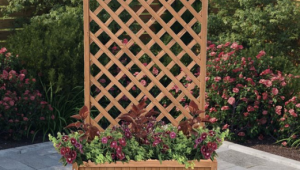Jump to:
Greenhouse ventilation can make or break your plants. Too little airflow, and you’ll get humidity and mould; too much, and it can get chilly or lose heat fast. A bit complicated, isn’t it, especially if you’re new to this? But this guide will show you how to get it right.
What Is the Best Way to Ventilate a Greenhouse?
(Customer’s Image: BillyOh Rosette Hobby Aluminium Polycarbonate Greenhouse)
There are different ways to ventilate a greenhouse. Roof and side vents work best together—they move hot air out and pull fresh air in. Automatic openers can handle this for you if you want a set-and-forget approach. They open vents when it’s warm and close them when it cools.
One roof vent and one side vent will do in a small greenhouse. But if yours is on the bigger side, you may want to make it two for each, or one set but with fans.
Fans are always handy for areas that vents don’t cover. Watch how air moves during the day and feel free to adjust if some spots feel hotter than others.
Do Greenhouses Need Ventilation in Winter?
Yes, your greenhouse needs ventilation in winter. Even on cold days, moist air can sit still inside, and that can lead to damp and mould.
The trick is to let the air move without losing too much heat. Open the vents a little on sunny days. If it’s a colder greenhouse, a small fan can help with the circulation.
Tip: Check the corners and near the roof, as air tends to get trapped there. Open the top vent a little while leaving the lower vents mostly closed.
How Much Ventilation Does a Small Greenhouse Need?
For a small greenhouse, a good starting point is vents that can open about 15 to 20% of the floor area. You can adjust depending on the season. On hot summer days, open more vents to prevent the temperature from spiking. In winter, keep them mostly closed, only cracking them to release damp air.
For a bigger structure, you’ll usually need multiple roof and side vents, and in some cases, a fan system. Balance intake and exit points so air flows through the whole space.
Keep an eye on your plants, too. If leaves look stressed or you see condensation, adjust the vents. One vent might not reach every corner; open a few in different spots, if possible.
Vent Position Ideas for Your Greenhouse
(Customer’s Image: BillyOh Rosette Hobby Aluminium Polycarbonate Greenhouse)
Hot air rises, which makes roof vents best at the top. Side vents near the bottom pull in cooler air, keeping the greenhouse from getting stuffy.
Avoid blocking them with plants, shelves, or tools. Otherwise, the flow will be uneven, and some parts will stay warmer or damper.
Don’t overlook the direction of prevailing winds, either. If your vents line up with the usual breeze, airflow improves without needing fans. Even a slight adjustment in orientation can make airflow more consistent.
Best Time of Day to Open Vents
Try opening vents in the morning. If you leave them open too long, some areas can stay damp or trap heat unevenly. That’s why you need to close them before night keeps things balanced.
Close the vents if it’s cold outside to avoid sudden temperature drops, but you don’t have to wait until it’s freezing. Even partially, it can trap enough warmth.
Round-up
Ventilation can feel tricky, but you can make it work. Keep an eye on how the air moves and notice where it lingers. Small changes, like adjusting a vent or adding a fan in a quiet corner, can make a difference. Pay attention to your plants as well because they’ll show you if things need tweaking.
Get more tips here: Easy Ways to Keep Your Greenhouse Warm in Winter














What do you think ?